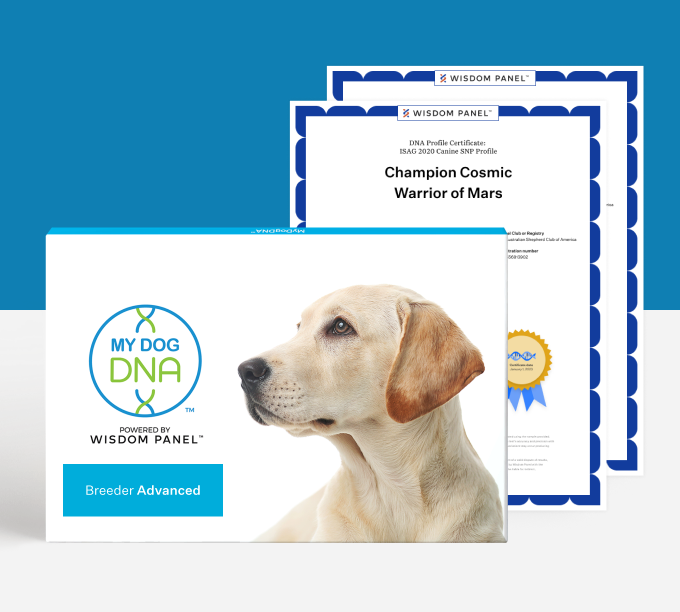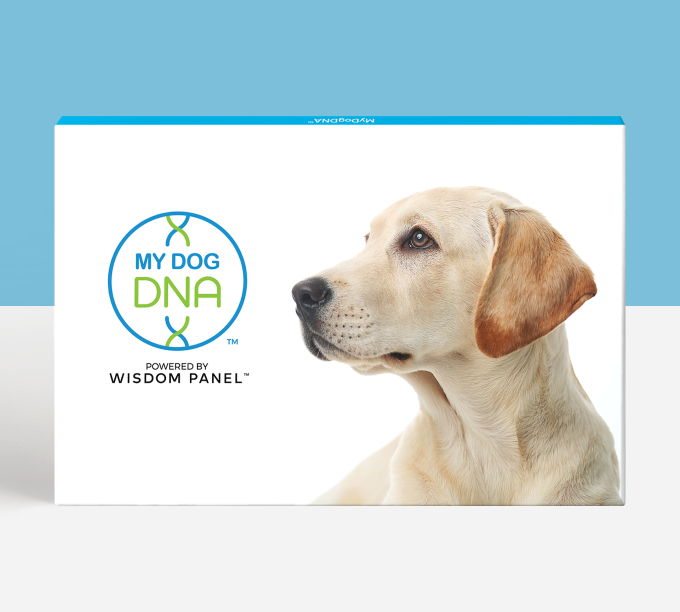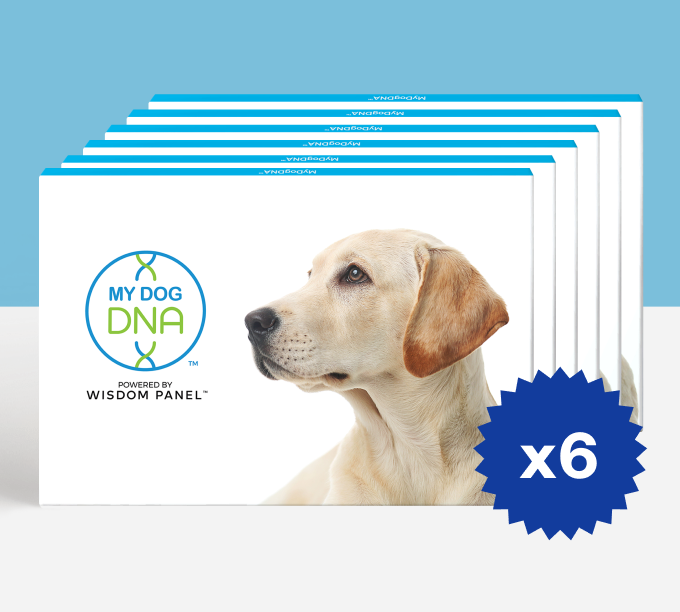At Wisdom Panel, we work continuously to advance our products so we can provide pet parents and breeders with the most comprehensive DNA insights. As part of that effort, we’re thrilled to announce the inclusion of the Chondrodystrophy (CDDY) and Intervertebral Disc Disease (IVDD) Risk variant to our panel of genetic health tests.
What Is CDDY and IVDD? (And why is testing important?)
If your pup is a member of the “short leg club,” listen up. Chondrodystrophy is a skeletal disorder characterized by disproportionate growth, best demonstrated by dogs having shortened legs. The form of CDDY associated with this genetic variant is also linked to the development of intervertebral disc disease (IVDD), which predisposes dogs to spinal disc herniation, or having a “slipped disc.” Let’s dive into the details.
First, a little helpful background on the genetics involved. In dogs, a gene called FGF4 (fibroblast growth factor 4) is involved in embryonic development, particularly appropriate growth. And FGF4-retrogenes are duplications of the original FGF4 gene that map to a different location in the dog genome.
The CDDY-associated genetic variant is an FGF4-retrogene insertion on dog chromosome 12, discovered by researchers in the Bannasch Laboratory at the University of California, Davis (Brown et al. 2017). For those who may be familiar, this is different from the FGF4-retrogene insertion on dog chromosome 18 (Parker et al. 2017), which is associated with a short-legged phenotype known as chondrodysplasia (CDPA). If you’re curious whether your dog has inherited either variant, both can both be found within Wisdom’s trait reporting. Although, the CDDY variant will also appear within the health section of the report due to its potential impacts on your pup’s well-being.
CDDY follows a semi-dominant mode of inheritance. This means dogs with one copy of the genetic variant typically have some shortening of their legs, whereas dogs with two copies will show a more obvious shortening. These dogs are also more likely to experience premature degeneration of the intervertebral discs and the calcification of the discs, a process also known as intervertebral disc disease (IVDD).
Dogs with IVDD secondary to this variant have an increased risk of intervertebral disc herniation (IVDH). And, the risk for dogs developing IVDH follows a dominant mode of inheritance, meaning only one copy of the CDDY-associated variant is needed for a dog to be considered predisposed to disc herniation. However, it is worth noting that this variant is a risk factor and some dogs with one, or even two, copies of this variant may not go on to show signs of disc disease. Additionally, not all dogs affected by IVDD have the FGF4-retrogene insertion found on chromosome 12, indicating additional genetic or environmental causes for disc disease.
A look at the statistics
The CDDY and IVDD Risk variant is widespread across the dog population and, to date, has been identified in 81 breeds through Wisdom Panel testing. And the data further shows that 1 in 5 dogs tested have at least one copy. This is significant because the risk for a dog requiring back surgery due to disc herniation ranges from 5 to 15 times more likely in dogs with one to two copies of this genetic variant.
Due to the CDDY variant’s effect on leg length, dogs with one copy can be around 6% shorter and dogs with 2 copies may be around 10% shorter than average. This tends to be a less pronounced short stature than dogs who only inherit the other short-legged CDPA variant. But, when both variants are present, they can work in conjunction to provide a more enhanced short-legged appearance. However, it is worth mentioning that body conformation and having a long body relative to leg length may be another factor in disc herniation risk, with the concern being the pressure applied to the back during movement.
Are some breeds at higher risk than others?
For some breeds, the short legged appearance that this variant creates is breed defining, and is present in nearly all dogs of the breed. For example, the CDDY variant is present in 99% or more of the following breeds:
- Bavarian Mountain Hound
- Clumber Spaniel
- Continental Toy Spaniel
- Dandie Dinmont Terrier
- English Toy Spaniel
- Field Spaniel
- Skye Terrier
- Sussex Spaniel
- Cavalier King Charles Spaniel
- Dachshund
The CDDY variant is also present at high levels in many spaniel breeds and popular breeds such as the Poodle and French Bulldog. For these breeds, slowly breeding towards dogs with a slightly longer leg length—with help from tests such as MyDogDNA—could dramatically reduce the incidence of painful back issues in the breed population. For reference, a list of the breeds with an IVDD variant frequency above 5% appears at the end of this post.
A deeper dive into IVDD and IVDH
Dogs who inherited the CDDY and IVDD Risk variant can demonstrate its effects from a very young age. Even at 1 week old, these pups can show indications of disproportionate growth, where they have short limbs with an average sized body and head. What is less apparent, however, is that these dogs can also have early degeneration and calcification of their spinal discs, which act as cushions between the vertebrae. Due to the changes in the natural cushions between the vertebrae, these dogs may experience a variable decrease in flexibility. And, it’s this disc degeneration, or IVDD, that predisposes them to disc herniation, or IVDH, during their lifetime. Indications of changes consistent with IVDD—such as narrowed intervertebral disc spaces or the calcification of the discs—may show up on diagnostic imaging (but not always). So it’s important to have a conversation with your veterinarian about ways to monitor for disc disease.
IVDH can be grouped based on the nature of the disc disease present. The condition associated with the CDDY and IVDD Risk variant is most characteristic of Type 1 IVDH, where the spongy middle portion of the spinal disc ruptures through the more fibrous outer layer of the disc, often compressing the spinal cord. While larger breeds can be affected, Type 1 IVDH is most common in smaller dog breeds. And the age of disc herniation diagnosis varies greatly between the different breeds, with the median age of dogs presenting for surgery ranging from 3 to 10 years. Dogs may also experience IVDD—and thus IVDH—in multiple locations during their lifetime. However, as the clinical signs are most often due to spinal cord compression by the disc material, if the disc herniates in a direction that does not involve the spinal cord, these dogs may appear otherwise asymptomatic. Research has shown that this may occur in 21% of asymptomatic dogs with one or two copies of the CDDY-associated variant.
For dogs who experience clinical disc disease, one of the initial signs can appear as back pain. This pain is often demonstrated by generalized stiffness or keeping an arched back, shivering or shaking, muscle spasms, hesitation to move, or vocalization when being touched. Key signs of disc herniation that compresses the spinal cord also include lameness, limb weakness, paw knuckling when walking, incoordination when walking (ataxia), or the inability to walk (paralysis). Some dogs may also experience fecal or urinary incontinence.
If you notice any of these signs, have your dog examined by a veterinarian as soon as possible for diagnosis and to pinpoint the region of affected spinal discs. Identifying the region is important because disc herniation along the back tends to affect the hind legs, whereas disc herniation in the neck can affect all four limbs. And, while anywhere along the spine can be affected, the area in the middle of the back is particularly prone. Your veterinarian will also assess the severity of your dog’s condition, as dogs experiencing paralysis without deep pain sensation are the most critical to receive emergency care.
How is disc herniation treated?
Treatment for disc herniation focuses on medical management and/or surgical intervention, with both approaches including strict crate rest. Deciding the type of treatment to pursue involves a number of factors that should be considered on a case-by-case basis. These factors include the speed of onset, severity of condition, proximity to specialised veterinary care, and financial considerations. Similarly, the success of treatment and general prognosis depend on several factors, particularly the severity and duration of signs.
Medical management is most successful in dogs experiencing back pain who are still able to walk independently. Typically, this approach includes weeks of complete activity restriction (in other words, crate time) paired with medication to address pain and inflammation. The goal of treatment is to allow plenty of time for a scar to form over the ruptured disc(s), reducing pressure on the spinal cord and preventing future ruptures of additional disc material. Prognosis with medical management can vary greatly depending on the factors of the individual case. And it’s important to note that recurrence can occur, especially if the dog is allowed to return to activity too quickly.
Back surgery, such as a hemilaminectomy, is typically recommended for dogs that cannot walk or those experiencing chronic back pain. The purpose of the procedure is to surgically remove the herniated disc material compressing the spinal cord. Following surgery, weeks of complete activity restriction are necessary for healing. Prognosis following surgery is often good for dogs who cannot walk but can still feel their feet. However, time is of the essence for dogs that cannot walk and cannot feel deep pain, as surgery is only successful in 50% of these cases if surgery is performed within the first 24 hours. After that time period, the rate of successful recovery falls dramatically.
Back surgery requires specialised tools and knowledge, so it’s usually performed by veterinary specialists. In addition, advanced imaging techniques, like magnetic resonance imaging (MRI) are needed to pinpoint the exact location of slipped disc(s) for the procedure. Therefore, availability and cost of these services are important considerations.
What to do if your dog is at risk
The development of disc disease in dogs is complex and multifactorial, and includes a number of genetic and environmental risk factors. The CDDY and IVDD Risk variant tested by Wisdom is just one of the considerations for understanding a dog’s unique predisposition to disc herniation. Not every dog with one, or even two, copies of the tested variant will go on to show signs of disc herniation.
Unfortunately, it’s not possible to completely prevent IVDD for dogs who are predisposed. However, maintaining a lean body weight and healthy musculature are key for any dog that is at risk of disc herniation during their lifetime. A healthy weight will prevent undue strain on the spine and other joints, while regular exercise—like uphill walks or swimming—can build strong back muscles to support the spine. On the flip side, it’s best to avoid high-impact activities that could cause twisting or compression of the spine. And, for senior dogs needing a little extra assistance, ramps will allow them to more easily access furniture or get into the car.
As with all things that could affect your dog’s well-being, be sure to discuss any insights uncovered through genetic testing with your veterinarian—including if your dog is considered at an elevated risk for developing disc herniation.
Breeds with an IVDD variant frequency above 5%*
- Bavarian Mountain Hound: 100%
- Clumber Spaniel: 100%:
- Continental Toy Spaniel: 100%
- Dachshund: 100%
- Dandie Dinmont Terrier: 100%
- English Toy Spaniel: 100%
- Field Spaniel: 100%
- Skye Terrier: 100%
- Sussex Spaniel: 100%
- Cavalier King Charles Spaniel: 99%
- Cocker Spaniel: 99%
- English Cocker Spaniel: 94%
- Cardigan Welsh Corgi: 94%
- Beagle: 93%
- Welsh Springer Spaniel: 92%
- French Bulldog: 88%
- American Water Spaniel: 83%
- Polish Lowland Sheepdog: 83%:
- Poodle (Toy): 82%
- Pembroke Welsh Corgi: 80%
- Entlebucher Mountain Dog: 77%
- Sealyham Terrier: 75%
- Spanish Water Dog: 72%
- Papillon: 68%
- Basset Hound: 68%
- Stabyhoun: 67%
- Poodle (Miniature): 63%
- Boykin Spaniel: 59%
- Kooikerhondje: 56%
- Alpine Dachsbracke: 50%
- Schapendoes: 48%
- Pekingese: 42%
- Chinese Crested: 32%
- Nova Scotia Duck Tolling Retriever: 29%
- Coton de Tulear: 28%
- Drever: 25%
- Lowchen: 25%
- Puli: 25%
- Chinook: 24%
- English Springer Spaniel: 24%
- Bedlington Terrier: 23%
- Danish Swedish Farmdog: 21%
- Bichon Frise: 21%
- Biewer Terrier: 20%
- Tibetan Terrier: 16%
- Shih Tzu: 16%
- Mi-ki: 16%
- Pyrenean Shepherd: 16%
- Lhasa Apso: 15%
- Schnauzer (Miniature): 12%
- Tibetan Spaniel: 12%
- Portuguese Water Dog: 10%
- Russian Tsvetnaya Bolonka: 10%
- Havanese: 9%
- Miniature Pinscher: 7%
- Yorkshire Terrier: 6%
- Presa Canario: 6%
- Chihuahua: 6%
- Russell Terrier: 5%
*frequencies provided via the Wisdom Panel database








